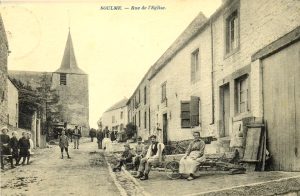Sainte-Colombe church Soulme
A blend of Romanesque and Gothic, the Sainte-Colombe church is the only building in the locality to have survived the centuries.

A blend of Romanesque and Gothic, the Sainte-Colombe church is the only building in the locality to have survived the centuries.

SOULME vue ancienne – rue de l’église
At the top of the village, lined with chestnut trees and surrounded by an old walled cemetery, this church of Romanesque origin dates back to the 11th century. In 1057, Soulme became part of the heritage of the Abbey of Florennes.
The massive 11th-12th century tower, which played both a military and religious role, dates from this period. While magnifying the place of worship, it also provides a watchtower and, if necessary, a refuge. The thickness of the walls attests to this defensive function (the present entrance gate was not built until much later).
The flat choir and the base of the nave are Gothic and date from the 13th century. The nave and side aisles are from the 16th century.
The altar dedicated to the patron saint of the parish, Sainte-Colombe, a virgin martyr, is to be found in the south aisle. The portal of the tower dates from the beginning of the 19th century and is in the neo-classical style.
The conflicts that have ravaged the village over the centuries have certainly left their mark on the building on several occasions.
However, the Sainte-Colombe church is the only building in the village that has survived the centuries.
In partnership with “Eglises Ouvertes”, this church can be visited all year round.
For more information, see our heritage page.
ÉGLISE SAINTE-COLOMBE
Rue Sainte-Colombe, 17 – 5680 Doische
MAISON DU TOURISME PAYS DES LACS
Route de la Plate Taille, 99 – 6440 Boussu-lez-Walcourt
+32(0)71/14 34 83
OFFICE DU TOURISME DE DOISCHE
Rue du Bois du Fir, 115 – 5680 Doische
+32(0)82/74 49 42
The association Les Plus Beaux Villages de Wallonie (The Most Beautiful Villages of Wallonia) oversees a network of 32 villages, bearers of a strong territorial identity and reflecting traditional architecture. It is committed to promoting the rural, cultural and natural heritage of Wallonia and is a part of the development of local and responsible tourism.
More information